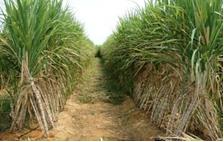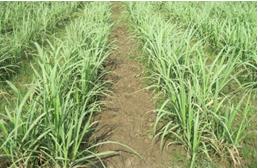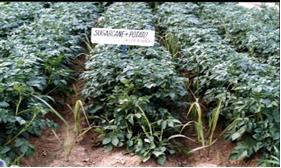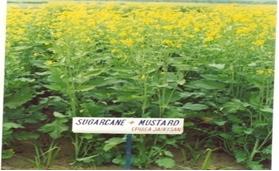Crop Production |
Crop production technologies for higher cane productivity and soil health
The increased pressure on soil to produce maximum cane yield has enhanced the use of chemical fertilizers without due considerations for soil health and supplementing micro-nutrients. It has resulted in yield plateau in sugarcane producing regions. The water economy in sugarcane has drawn attention of the researchers and policy makers. In order to provide user-friendly technology to the growers the recent advances in crop production to address the issues are given as under:
- Agronomic evaluation of promising sugarcane genotypes: Under this programme, promising varieties have been recommended to substitute existing old/low yielding sugarcane varieties in different zones.
- Resources conservation and management: The soil and water conservation techniques and their judicious use for sugarcane based sustainable production system were developed and recommended for different zones. Being long duration and high biomass producing crop its requirement for nutrients and water is quite high and therefore, requires comprehensive approaches including micro-irrigation techniques, use of bio-fertilisers and residue recycling to minimise the use of chemical fertilisers and improve the soil health.
- Under pre-planting conservation tillage techniques in sugarcane based cropping system, pre-planting tillage operations may be economized to the extent of 50% by using Rotavator twice over conventional tillage in late planted sugarcane crop following wheat crop in light soils
- Sub-soiling to break hardpan and improve input use efficiency: Development of a hard pan beneath the plough soil in sugarcane growing areas causes yield stagnation and crop lodging. To improve upon soil physico-chemical characteristics and sugarcane productivity, sub-soiling especially cross sub-soiling at 1.0 m is recommended for enhancing cane yield and sustaining soil health.
- Fertilizer requirement for promising sugarcane genotypes: There is great deal of genetic variations in cane yield and quality across the zone. Hence, superior clones be recommended to substitute old/inferior varieties. In NWZ/NEZ/NCZ/ECZ, sugarcane crop be fertilized with the 100% recommended dose of fertilizer, whereas in peninsular zone, sugarcane crop be fertilized with 25% more of the recommended dose of fertilizer.
- Developing organic farming module for sugarcane crop:
Application of 75% recommended NPK (inorganic) + 25% N through organic manures + bio-fertilizer + bio-pesticide in plant crop and 75% recommended NPK (inorganic) + 25% N organic + bio-fertilizer + trash mulch and green manure crop in alternate rows + bio-pesticide in ratoon crop significantly improved cane productivity in plant and ratoon crops over the recommended NPK + micronutrient through inorganic + pest /disease control through chemical mode.
- For sustaining sugarcane production and soil health, sugarcane plant crop should be fertilized with 100% of the recommended NPK fertilizers + 25% N through FYM + bio-fertilizers (Azotobacter + PSB) @ 5 kg/acre (solid based fertilizer 107-8 cfu) and 100% of the recommended NPK through inorganics + trash incorporation with cellulolytic culture+ bio-fertilizers in ratoon crop is advocated to sustain higher cane yield and sugar recovery. This also improves soil health by enriching the organic carbon content of the soil.
- In North West, North East and East Coast Zones, sugarcane crop be fertilized with 60 kg P2O5/ha. However, in Peninsular Zone, DAP was superior to SSP and sugarcane crop be fertilized with 60-80 kg P2O5/ha. As regards, zinc nutrition, 20-30 kg ZnSO4/ha was sufficient to improve productivity.
- Nutrition for improving productivity of winter initiated ratoon: Fresh sulphitation press mud cake (SPMC) @ 20 t / ha at ratoon initiation is recommended for improving bud sprouting and cane yield in winter initiated sugarcane ratoon. Alternatively, 10 t fresh SPMC + 25 kg ZnSO4/ha is also recommended.
- Use of organics: Addition of 20 t/ha FYM/ compost along with inorganic fertilizers applied on the basis of soil test, soil test crop response for targeted yield or on the basis of general recommendation for the region has shown positive effect on sugarcane growth and yield both in plant and ratoon crops. Response of sugarcane to bio-fertilizers (Azotobacter/ Acetobacter/ Azospirillum/ PSB) was more pronounced in Peninsular Zone. Use of organic sources of nutrients in plant ratoon system brings about substantial enhancement of soil health parameters in most of the sugarcane growing soils. Saliant findings has been given below:
- Combined application of organic and inorganic sources of nutrients was found conspicuously better over the use of fertilizers alone across the centres located in different agro-climatic conditions.
- Sugarcane trash used as mulch in ratoon crops has little contribution as a source of nutrients as organic amendments like FYM or compost recorded significant improvement in cane and sugar yield over that with trash mulching under the use of recommended dose of fertilizers across the locations.
- Use of organic sources of nutrients in plant ratoon system brings about substantial enhancement of soil health parameters in most of the sugarcane growing soils.
- Compatibility of zinc application with sources and levels of phosphorus in sugarcane: SSP and DAP were equally effective as sources of phosphorus. In North West, North East and East Coast Zones, sugarcane crop be fertilized with 60 kg P2O5/ha. However, in Peninsular Zone, DAP was superior to SSP and sugarcane crop be fertilized with 60-80 kg P2O5/ha. As regards, zinc nutrition, 20-30 kg ZnSO4/ha was sufficient.
- Carbon sequestration assessment in sugarcane based cropping system:
- In the north-west zone, use of sugarcane trash as mulch with or without
Trichoderma inoculation in the ratoon crop resulted in highest sugarcane equivalent yield and brought about palpable improvement in soil health indicators.
- Trash mulching along with the use of Trichoderma in ratoon crop yielded in highest cane equivalent yield of the system comprising sugarcane- ratoon- cowpea/ greengram crops in peninsular and east-coast zones.
- For north central zone, ratavator operation after ratoon harvest followed by spray of
Trichoderma resulted in highest cane equivalent yield in sugarcane –ratoon – wheat cropping system.
Nutrients management agro-techniques
Water management agro-techniques
Water is a very precious input in sugarcane production while depletion of ground water and droughts are becoming common. Therefore, for economic use of irrigation water without affecting sugarcane production and productivity, micro irrigation system in future is going to be a necessity.
|
Sub-surface drip irrigation:
|
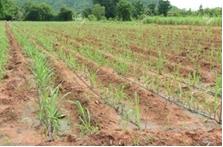
|
|
Skip-furrow/alternate furrow irrigation:
|
 |
Evaluation of sugarcane varieties for drought tolerance
- Moisture stress during pre-monsoon growth phase brought about significant reduction in cane yield across all the zones. The loss in yield ranged within 20 to 35 % in different sugarcane growing zones.
- Water efficient sugarcane varieties belonging to early and mid-late maturity groups were identified for different zones.
Scheduling irrigation with mulch under different sugarcane planting methods
- Planting of sugarcane in paired rows (120: 30) with mulching of trash (6 t/ha) in the inter-row spaces out yielded the conventional flat method with or without mulch at all the centres in north western, north central and north eastern zones. Trash mulching could effectively save 20-26% irrigation water over no-mulching.
- Sugarcane crop in peninsular and east coast zones responded to furrow planting (120 cm) and skip furrow irrigation combined with the use of leguminous crop as green manure till 75 DAP as mulch during tillering and thereafter residue incorporation.
- As per irrigation regimes, IW/CPE ratio 1.0 resulted in higher cane productivity. However, it could be restricted to 0.8 for getting higher water use efficiency in these zones.
- Use of mulch in sub-tropical zone and green manuring followed by mulching and residue incorporation resulted in higher net return.
Weed management agrotechniques:
Presence of weeds interferes with the growth and development of the crop and ultimately reduces the cane yield. Among various reasons for the loss in cane yield, intense competition by weeds to the crop for nutrients, moisture and space is the most important one.
- For weed management in sugarcane, Metribuzin 1.0 kg ai/ha or Ametryn @ 2.0 kg ai/ha as pre-emergence is as effective as earlier recommended pre-emergence herbicide atrazine@ 2.0 kg ai/ha. Either of these herbicides should be coupled with application of 2,4-D @ 1.0 kg ai/ha at 60 days after planting (DAP) and one hoeing at 90 DAP to sustain cane yield equivalent to three manual hoeings at 30, 60 & 90 DAP.
- Three hoeings at 1st, 4th, and 7th weeks after ratoon initiation should be adopted for effective control of weeds in sugarcane ratoon crop. However, under limitations of manpower-availability, cost etc., pre emergence application of Atrazine @ 2.0 kg a.i./ha or Metribuzin @ 1.0 kg a.i./ha (800- 1000 litre water/ha) followed by either of 2,4 D Na salt @ 1.0 kg/ ha(600-800 l water/ha) or hoeing at 45 days after ratooning can be successfully practiced.
- Trash mulching in alternate rows and hoeing in unmulched furrows at 1st & 6th weeks after ratoon initiation has also been found a good option.
- Binding weed is a perpetual problem in sugarcane ratoon particularly under water-logged conditions: Application of Atrazine @ 2 kg ai/ha or metribuzine @ 1.25 kg ai/ha as pre- emergence followed by Dicamba @ 350 g ai/ha at 75 DAP is effective for controlling binding weeds in sugarcane.
Germination and plant population management agro-techniques:
To reduce human drudgery in various field operations mainly harvesting and facilitate intercultural operations, wider row spacing of 120 cm/30:150 cm is recommended for tropical zone to facilitate the mechanical harvesting as well as maintaining cane yield level. However, in sub-tropical zone, sugarcane planting at 30:120 cm is an option to facilitate mechanization.
- Trench method of planting has been recommended for higher cane yield from sugarcane plant crop and good subsequent ratoon. It avoids crop lodging for higher plant growth on light soils and suitable for higher cane and sugar yields with increased input use efficiency.
|
|
|
|
Sugarcane crop planted in Trench method |
Placing of setts (Two rows in one trench) |
Crop diversification in sugarcane:
- Intercropping in Sugarcane:
|
|
|
|
Sugarcane + Potato |
Sugarcane + Mustard |
Suitable intercrops with sugarcane identified for tropical region
| Planting season | Intercrops |
| Seasonal (Suru) | Groundnut (summer), soybean, water melon, cucumber |
| Pre-seasonal | Potato, gram, cabbage, cauliflower, onion |
| Adsali | Groundnut, soybean, cowpea, radish, coriander, fenugreek. |
Control of flowering
In Peninsular Zone, foliar spray of Ethrel @ 250-300 ppm (2.5 – 3.0 ml/10 litres water) at 4 month stage of the crop was effective in controlling flowering in sugarcane and obtaining higher cane yield as well as improved juice quality. However, in East Coast Zone, crop responded up to 500 ppm of Ethrel spray.

